The botulism outbreak that sickened dozens at a Ohio church potluck dinner in April has been linked to potato salad prepared with improperly home-canned potatoes, according to a Centers for Disease Control and Prevention (CDC) report published Friday.
The outbreak that affected 29 and killed one was the largest botulism outbreak in the United States in more than 30 years.
 The source of the outbreak, according to the investigation, was potato salad prepared with improperly home-canned potatoes, a known vehicle for botulism, which was served at a Fairfield County, Ohio church potluck on April 19.
The source of the outbreak, according to the investigation, was potato salad prepared with improperly home-canned potatoes, a known vehicle for botulism, which was served at a Fairfield County, Ohio church potluck on April 19.
The CDC points out the work of a “astute clinician” and a rapid, coordinated response which likely reduced illness severity. The coordinated response included the CDC’s Strategic National Stockpile who sent 50 doses of botulinum antitoxin to Ohio.
The attendee who prepared the potato salad with home-canned potatoes reported using a boiling water canner, which does not kill C. botulinum spores, rather than a pressure canner, which does eliminate spores. In addition, the potatoes were not heated after removal from the can, a step that can inactivate botulinum toxin. The combined evidence implicated potato salad as the source of the large outbreak.
Food borne botulism is a severe intoxication caused by eating the preformed toxin present in contaminated food.

Image/ Alcinoe
Food borne botulism occurs when the bacterium Clostridium botulinum is allowed to grow and produce toxin in food that is later eaten without sufficient heating or cooking to inactivate the toxin. Botulinum toxin is one of the most potent neurotoxins known.
Growth of this anaerobic bacteria and the formation of the toxin tend to happen in products with low acidity and oxygen content and low salt and sugar content. Inadequately processed, home-canned foods like asparagus, green beans, beets, and corn have commonly been implicated.
However, there have been outbreaks of botulism from more unusual sources such as chopped garlic in oil, chili peppers, improperly handled baked potatoes wrapped in aluminum foil and home-canned or fermented fish. Garden foods like tomatoes, which used to be considered too acidic for the growth of Clostridium botulinum, is now considered a potentially hazardous food in home canning.
Though more common in home-canned foods, it does happen occasionally in commercially prepared foods.
Typically in a few hours to several days after you eat the contaminated food you will start to show the classic symptoms; blurred vision, dry mouth, and difficulty in swallowing. Gastrointestinal symptoms may or may not occur. If untreated, the paralysis always descends through the body starting at the shoulders and working its way down.
The most serious complication of botulism is respiratory failure where it is fatal in up to 10% of people. It may take months before recovery is complete.
If the disease is caught early enough it can be treated with antitoxin. If paralysis and respiratory failure happen, the person may be on a ventilator for several weeks.
Related news:
West Nile virus in Ohio: 2 human cases in Cuyahoga and Hamilton Counties
Ohio: Governor John Kasich signs meningitis vaccine bill into law
Cat scratch disease results in Ohio woman’s blindness
Ohio resident dies from H1N1v ‘swine flu’


3 thoughts on “Ohio botulism outbreak: Potato salad with home-canned potatoes made using a boiling water canner”